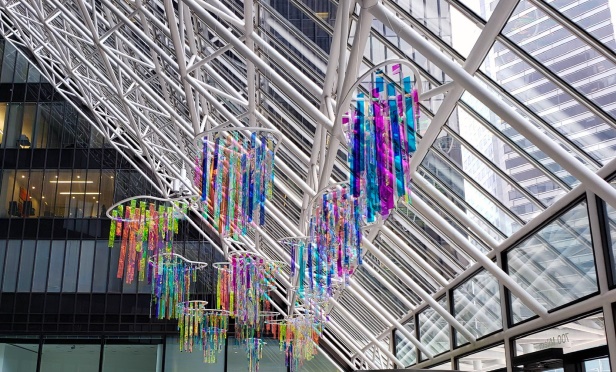 Abstract custom artwork, Holographic Sky, capitalizes on the natural light of the Pennzoil atrium.
Abstract custom artwork, Holographic Sky, capitalizes on the natural light of the Pennzoil atrium.
HOUSTON—Pennzoil Place was completed in 1975 and designed by architects Philip Johnson and John Burgee. The unique trapezoidal silhouette made it the first skyscraper of the Post-Modern Era. The class-A office property consists of two 36-story towers.
In 2016, the LEED Gold building at 711 Louisiana St. was named Outstanding Building of the Year by BOMA's Houston Chapter and re-certified for LEED Gold under the dynamic plaque platform. It is the first office building in Houston to utilize a fiber optic backbone for IT communication utilizing Cisco's Smart+Connected buildings framework which enhances data/communications, physical security and building automation capabilities. This allows for tenant comfort, quicker response times and ability to achieve the highest energy efficiency possible, GlobeSt.com learns.
Further accentuating its appeal is the abstract custom art installation recently put in place in the building's atrium. Design firm Gensler created the installation called Holographic Sky, which capitalizes on the abundant natural light of the iconic atrium.
Holographic Sky uses dichroic film to manipulate the effect natural light has in the space to create a cascade of color. Taking full advantage of the volume of Pennzoil's atrium, individuals will have the sensation of being surrounded by light and color.
Metropolis Investment Holdings Inc., owner of Pennzoil Place, and Transwestern Commercial Services partnered with Gensler on the installation. Transwestern provides leasing and property management services for the 1.4 million-square-foot high-rise.
“The team created an installation using innovative technologies that allow for futuristic forms to be built more easily,” said Angela Palmer, Gensler's architectural digital designer/associate. “This can be seen in the amorphous, abstract cloud forms that hover over the lobby entrance.”
Other Gensler team members involved in the project include Jordan Gomez, who focuses on high-rise design; Mark Talma, who is interested in redefining the perception of the built environment; Elizabeth Braun and Amber Porterfield.
“Holographic Sky was designed and constructed specifically for the Pennzoil Place architecture,” Palmer tells GlobeSt.com. “It celebrates the grandiose natural light of the architecturally iconic Pennzoil atrium by utilizing reflective dichroic materials which introduce the vibrant colors of Houston street art into the lobby. The hanging clouds take advantage of the volume of the space while also seeking to bring the scale of the lobby down to the pedestrian level.”
Holographic sky was created by Gensler Houston's grassroots group called Design Labs Houston, Palmer says. Design Labs Houston experiments and works with future technologies and practices in the design industry. Grasshopper with Rhinoceros 3D was used for the digital design.
“The installation was initiated as a way for the group to practice using computational software on a real project,” Palmer tells GlobeSt.com. “The scope had to be small enough for experimentation but Design Labs Houston was insistent on using parametric software in the design and construction. With this in mind, we began searching for the right project and came across the artist series hosted by Transwestern in the building Gensler Houston occupies, Pennzoil Place. On being accepted as their next artist, we became inspired by the architecture and wanted to celebrate its primary asset, all of the natural light that washes the atrium.”
The initial focus was to create a canopy of over visitors that would give them the impression of being under a prismatic or holographic sky, Palmer explains.
“We wanted to bring color into the lobby in a way that would interact with people and change throughout the day as the sun came in and out,” Palmer tells GlobeSt.com. “As we further developed the design and became more comfortable with Grasshopper, the group decided to move to a more organic shape that would really challenge us in construction and assembly. The new shapes were also a better representation of abstracted cloud formations hanging in the sky. We created a template in Grasshopper for each cloud that included the frame cut, the string pattern, and the length and location for each fin.”
Each grid string was hand strung and every fin was hand cut, all 952 of them, GlobeSt.com learns.
“We then placed all the fins along the string in their proper place and hung the clouds in the atrium,” Palmer tells GlobeSt.com. “Although the next day was rainy, the sun made an appearance and we were able to see the installation in full effect.”
© Touchpoint Markets, All Rights Reserved. Request academic re-use from www.copyright.com. All other uses, submit a request to [email protected]. For more inforrmation visit Asset & Logo Licensing.







